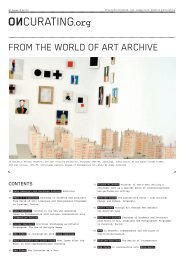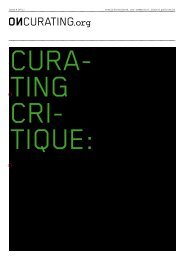Create successful ePaper yourself
Turn your PDF publications into a flip-book with our unique Google optimized e-Paper software.
067 Issue # 11/11 : PublIc Issues<br />
receive invitations to other occ<strong>as</strong>ions <strong>as</strong> Oda Projesi. The<br />
names of the participants are always shared, but for the<br />
next round we are invited again <strong>as</strong> three people. Therefore<br />
it's not possible to cancel out signature. But constantly<br />
protecting one's own attitude and signature would be quite<br />
problematic for a formation like ours. Oda Projesi does<br />
not have a clear-cut style or attitude. As Özge h<strong>as</strong> just<br />
tried to explain, we are trying to deal with the burden<br />
of signature by sharing it in various sites and in many<br />
projects, inscribing it commonly into projects undertaken<br />
with other people.<br />
Özge: I am not calling for a full cancellation; what I am<br />
trying to do is to underline the relation of signature to<br />
audience. What I meant w<strong>as</strong> this: if there is no audience<br />
at the moment of realisation, then there is no need for<br />
signature. But this moment is crucial. If someone observed<br />
us during the project or entered it from the outside <strong>as</strong><br />
a participant, then the project would take another shape.<br />
Video-recordings are a different matter since the decision<br />
whether to use them or not is up to you; they can also be<br />
seen <strong>as</strong> dead archival material. It is not theatre or<br />
staging, this is what I mean: we all become an audience or<br />
we don't become an audience at all... Our one-day projects<br />
required face-to-face relations and intimacy; they were<br />
close to private life, even mimicking it – something like<br />
bringing an object from your home or celebrating someone's<br />
birthday... What I wanted to say w<strong>as</strong> that the absence<br />
of audience in the moment of experiencing an intensive re-<br />
lationship helps to establish a healthier relationship.<br />
Here the issue of sharing resurfaces. The field of art is<br />
actually a space in which we can share these things. It<br />
is a field that we value <strong>as</strong> democratic, that we want<br />
to become democratic, or that, we think, h<strong>as</strong> to be demo-<br />
cratic.<br />
Derya: Art h<strong>as</strong> been something that is seen, watched,<br />
looked at, that appeals to sight, or is something forever<br />
visual. The question about why it h<strong>as</strong> been so and similar<br />
questions that follow from such a view are also significant.<br />
Even conceptual art cannot become a lived thing, even<br />
though it appeals to the senses other than seeing. Here,<br />
we can link our discussion to the art historical debates<br />
about the relationship between art and life, and to dis-<br />
cussions about art movements such <strong>as</strong> Dadaism and Fluxus.<br />
Özge: Do you consider the practices of Oda Projesi con-<br />
ceptual art? It is partly true, of course, when we say<br />
that Oda is a proposal for a project. This question<br />
actually bugs me <strong>as</strong> well. On the other hand, categorisations<br />
such <strong>as</strong> social art and so on are also very restric-<br />
tive 13 . Reflections on Oda Projesi should not be devoid<br />
of considering the localities that it is tied to. Perhaps<br />
it is a particular category in itself. Perhaps we should<br />
read different types of art formations from that angle.<br />
For example, in which category would you locate Hafriyat<br />
or HaZa VuZu art collectives? In the c<strong>as</strong>e of Oda Projesi,<br />
we can perhaps open up the discussion about the issue<br />
of authorship through the notions of artwork and audience.<br />
And we can also discuss the problems of studying groups<br />
like Oda Projesi from the outside. I guess that just<br />
because of these problems we strive for establishing<br />
face-to-face contacts. For instance, <strong>as</strong> we did in Tensta,<br />
tactics like the artist's presence next to his or her<br />
work, his or her direct contact with each visitor, which<br />
attempt to facilitate mental participation, become<br />
prominent. 14 Or the preference of the speaker's mode over<br />
those of the author or the writer...<br />
Derya: Does this lead us<br />
to suggest that we speak to<br />
rather than listen to the<br />
other? There is also a re-<br />
ference to that in Necmi<br />
Erdog˘an's states of Poverty.<br />
Presentation<br />
Özge: Let's also consider<br />
Gayatri Spivak's can the sub-<br />
altern speak? Spivak cri-<br />
ticises Gilles Deleuze for<br />
charging the concept of<br />
representation with a single<br />
meaning. She is especially<br />
critical of the following<br />
<strong>as</strong>sertions made by Gilles<br />
Deleuze: "A theory is exactly<br />
like a book of tools. It h<strong>as</strong><br />
nothing to do with the<br />
signifier." Or "representation<br />
no longer exists; there<br />
is only action" (Deleuze<br />
1977, p. 205). In response,<br />
Spivak makes a distinction:<br />
"two senses of representa-<br />
tion are being run together:<br />
representation <strong>as</strong> 'speaking<br />
for,' <strong>as</strong> in politics, and<br />
representation <strong>as</strong> 'represen-<br />
tation' <strong>as</strong> in art or philo-<br />
sophy. Since theory is also<br />
only 'action,' the theore-<br />
tician does not represent<br />
(speak for) the oppressed<br />
group. Indeed, the subject is<br />
not seen <strong>as</strong> a representative<br />
conciousness (one represent-<br />
ing reality adequately)."<br />
This distinction touches up-<br />
on the issues we are trying<br />
to discuss here. On which<br />
side of this distinction does<br />
Oda Projesi stand? We don't<br />
speak for others but represent;<br />
could we put it like<br />
that?<br />
Günes¸: This is an important<br />
question. Re-presenting<br />
or proposing something new?<br />
Let's consider an example,<br />
the radio project... Radio<br />
is b<strong>as</strong>ically a means of<br />
communication. And what Oda<br />
Projesi did in the context<br />
of radio w<strong>as</strong> to design sound<br />
collages b<strong>as</strong>ed on distorted<br />
sounds and interferences.<br />
So w<strong>as</strong> Oda Projesi proposing<br />
a new radio methodology or<br />
only reflecting upon a multi-<br />
plicity of possibilities<br />
through a change of methods?<br />
Özge: There is actually no new<br />
proposal in representation.<br />
13<br />
(http://www.<br />
republicart.net/<br />
disc/aap/kravagna<br />
01_en.htm).<br />
Kravagna, 1998<br />
14<br />
Proje4l took place<br />
in Tensta Konst-<br />
hall, Stockholm,<br />
between August 17th<br />
– October 24th,<br />
2004. It w<strong>as</strong> the<br />
first exhibition of<br />
the institution<br />
after it w<strong>as</strong> re-<br />
opened under the<br />
curatorship of Ylva<br />
Ogland, Rodrigo<br />
Mallea Lira, and<br />
Jelena Rundqvist.<br />
Oda Projesi w<strong>as</strong><br />
unfamiliar with the<br />
institution and its<br />
neighbourhood. In<br />
order to have a con-<br />
tact with the dyn-<br />
amics of the context,<br />
the members of Oda<br />
Projesi set out to<br />
study Tensta and to<br />
employ the art space<br />
<strong>as</strong> a means to gene-<br />
rate some energy out<br />
of the existing<br />
social networks.<br />
Tensta is a suburban<br />
district which is<br />
populated mostly by<br />
large families from<br />
migrant backgrounds<br />
living in five-floor<br />
apartment blocks.<br />
The title of the<br />
project refers to<br />
the Proje 4L con-<br />
temporary art museum<br />
in Istanbul. The<br />
museum w<strong>as</strong> located<br />
in Gültepe, close to<br />
working-cl<strong>as</strong>s neigh-<br />
bourhoods. Oda Pro-<br />
jesi remained in<br />
Tensta for the dura-<br />
tion of the entire<br />
project. A series of<br />
working islands were<br />
created in the art<br />
space and each is-<br />
land, marked with<br />
yellow on the ground,<br />
referred to specific<br />
spaces in Tensta:<br />
library, shopping<br />
mall, women's<br />
center, school, gym,<br />
and so on. One of<br />
these islands, whose<br />
shapes were deter-<br />
mined according to<br />
the geometric pro-<br />
jection of their<br />
reference spaces,<br />
w<strong>as</strong> atttributed to<br />
the flat of Oda<br />
Projesi in Galata,<br />
and this space<br />
hosted the documen-<br />
tation of Oda Pro-<br />
jesi's earlier<br />
works, including<br />
catalogues and other<br />
materials.


![Download as PDF [10.6 MB]](https://img.yumpu.com/4266533/67/500x640/download-as-pdf-106-mb.jpg)

